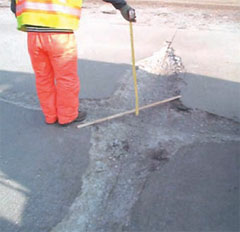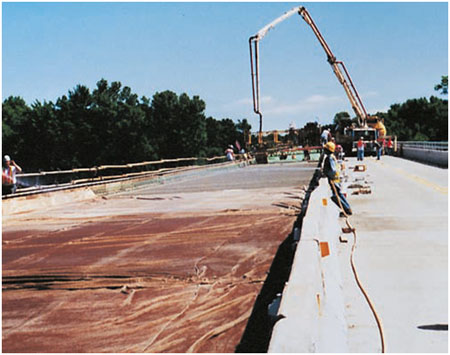 Figure 1. Joint deterioration (Courtesy of D. Harrington).
Figure 1. Joint deterioration (Courtesy of D. Harrington).
Concrete provides a durable, attractive paved surface for roads. It provides a longer life than any other leading paving materials and does not rut or shove due to traffic or warm temperatures. Concrete’s higher reflectance keeps surfaces cooler, helps minimize the urban heat island effect, and can lower infrastructure and ongoing lighting costs, while boosting safety for vehicles and pedestrians.
Pavement joint deterioration is the premature disintegration of concrete around the joint (Figure 1). This typically begins to show after several years in place. The mechanism behind joint deterioration is complex and is understood to have basis in freeze-thaw damage and mechanical damage.
Based on the current understanding of the mechanisms behind joint deterioration, there are four recommendations for new construction (Taylor 2011b):
- Quality concrete mixtures
- Properly entrained air void systems
- High quality curing
- Appropriate drainage
Quality Concrete Mixtures
The recommendations for producing quality concrete mixtures are a water-cementitious materials ratio (w/cm) between 0.38 and 0.45, use of supplementary cementitious materials, and using an aggregate with optimal gradation and good durability (Taylor 2011b). Kosmatka and Wilson, 2011, detail the fundamentals behind the use of a low, but not too low, water/centimeter (w/cm)—reducing permeability without creating excessive autogenous shrinkage. The appropriate use of supplementary cementitious materials can reduce permeability (Taylor 2011a and Kosmatka and Wilson, 2011).

The combined gradation of aggregates can be used to better control workability, pumpability, shrinkage, and other properties of concrete. The durability of aggregates is important, particularly in avoiding D-cracking. D-cracking is closely spaced crack formations oriented parallel to transverse and longitudinal joints that later multiply outward from the joints toward the center of the pavement panel (Figure 2).
Figure 2. D-cracking along a transverse joint caused by failure of carbonate coarse aggregate (Courtesy of J. Grove).
Entrained Air Void Systems
Recommendations for the air void system include accounting for air content losses during the placement process, monitoring the air content, adhering strictly to the air minima in the specification, and avoiding systems that are close to the recommended limits (Taylor 2011b). Per Kosmatka and Wilson, 2011, the recommended limits on an air void system are a minimum of 5 to 8 percent air content (3/4 inch nominal maximum size aggregate), a spacing factor equal to or below 0.008 inch and a specific surface area of air voids equal to or greater than 600 in.
2/in. In particular, ensuring a low spacing factor is more important in environments exposed to deicers. Chapter 9 of Kosmatka and Wilson, 2011, provides an extensive review of the effects of constituents and procedures on the control of air content in concrete.
Curing
Curing is the maintenance of a satisfactory moisture content and temperature in concrete for a sufficient period of time during and immediately following placing so that the desired properties may develop (Figure 1). The need for adequate curing of concrete cannot be overemphasized. Curing has a strong influence on the properties of hardened concrete. Curing improves strength, volume stability, permeability resistance, and durability (including abrasion resistance and resistance to freezing and thawing and deicer scaling). Exposed slab surfaces are especially sensitive to curing as strength development and durability of the top surface of a slab can be reduced significantly when curing is neglected. For most jobs, curing generally involves applying curing compounds, or covering the freshly placed and finished concrete with impermeable sheets or wet burlap. In some cases, such as in hot and cold weather, special care using other precautions is needed. For pavements, the length of the curing period for ambient temperatures above 40 degrees Fahrenheit should be a minimum of seven days (ACI 301).
 Figure 3. Curing should begin as soon as the concrete stiffens enough to prevent marring or erosion of the surface. Burlap sprayed with water is an effective method for moist curing.
Figure 3. Curing should begin as soon as the concrete stiffens enough to prevent marring or erosion of the surface. Burlap sprayed with water is an effective method for moist curing.
Drainage
The recommendations for appropriate drainage include ensuring the pavement is properly jointed, the base has some permeability, and that clogging potential has been addressed (Taylor 2011b).
Mitigation and Repair
While knowing how to prevent joint deterioration is critical for new concrete pavements, it does little to help in-place pavements that already exhibit signs of a problem. Recommendations for mitigation from Taylor, 2011b, include applying sealants to the concrete near the joints, limiting the types of deicers used to sodium chloride, repairs to the joint, unclogging drainage systems, and retro-fitting improved drainage systems. More information on sealants can be found in Kosmatka and Wilson, 2011. More information on joint repairs can be found in Frentress and Harrington, 2011, Kosmatka and Wilson, 2011, and Tarr and Farny, 2008.
References
Frentress, Daniel P. and Harrington, Dale, Partial-Depth Repairs for Concrete, MAP Brief 7-2, National Concrete Pavement Technology Center, Ames, Iowa, 2011, 4 pages.
Kosmatka, Steven H., and Wilson, Michelle L., Design and Control of Concrete Mixtures, 15th Edition, EB001-15, Portland Cement Association, Skokie, Illinois, USA, 2011, 460 pages.
Taylor, Peter C., “Fly ash as a supplementary cementitious material in concrete mixtures," MAP Brief 1-3, National Concrete Pavement Technology Center, Ames, Iowa, 2011, 4 pages.
Taylor, Peter C., Preventing Joint Deterioration in Concrete Pavements A Summary of Current Knowledge; MAP Brief 6-1, National Concrete Pavement Technology Center, Ames, Iowa, 2011, 4 pages.